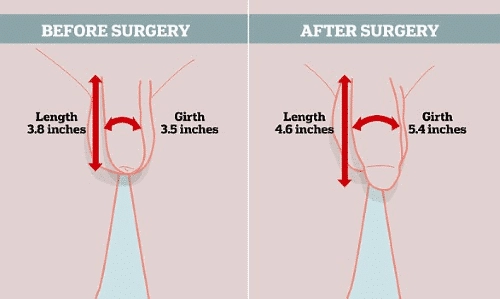INTRODUCTION
During a fat transfer procedure, the surgeon will remove fat cells from a fatty area of the body and inject them into the shaft of the penis. They do so by making small incisions into the sides of the penis and injecting purified fat cells into these areas.

INDICATIONS
Fat Transfer Penis Enlargement Surgery involves two surgical procedures that are completed during the same hospital visit.
In the first procedure, a liposuction of fat is performed from the abdomen or thighs. The fat is then
filtered so that fat cells are isolated and other material is discarded. Next, the fat is injected around
the penile shaft using bespoke injection techniques to ensure fat survival. As fat transfer cells come from the patient’s own body, there is no risk of allergic reaction.
The penile skin is thin in the area between the skin and the penile shaft, and this area does not have
a rich blood supply. As a result, fat grafting to the penis has traditionally proven unreliable, with the
main side effect being lumpiness, caused by fat necrosis.
It is critical that the fat transferred to the penis is pure, and the fat cells remain intact. To this end,
surgeon Dr Dr. Ashwani Kumar uses LipiVage or Puregraft fat processing technology.
LipiVage creates a closed circuit from the fat donor site (typically the stomach, flanks and lower
back) to the fat recipient site (the penis).
The closed-circuit improves the rate of fat survival and reduced the risk of infection as fat is not as
exposed to the air during removal and transfer.
PROCEDURE
There are a few different procedures for penis enlargement surgery, each of which has its own method.
Silicone implants
This type of surgery involves the insertion of a crescent-shaped piece of medical grade silicone under
the penile skin to make the penis longer and wider.
Currently, the Penuma procedure is the only penis enlargement surgery that the Food and Drug
Administration (FDA) have cleared for commercial use under the 510(k) regulation.
A surgeon first makes an incision above the penis and then inserts a silicone slip through it onto the
shaft of the penis. They will shape the silicone implant to ensure that it fits the size and shape of the
penis.
Fat transfer
During a fat transfer procedure, the surgeon will remove fat cells from a fatty area of the body and
inject them into the shaft of the penis.
They do so by making small incisions into the sides of the penis and injecting purified fat cells into
these areas.
Suspensory ligament division surgery, or ligamentolysis, offers a way to make the flaccid penis
appear longer by cutting the suspensory ligament. This ligament attaches the penis to the pubic
bone.
During the procedure, the surgeon will sever this ligament and move skin from the abdomen to the
shaft of the penis. Although this may make the flaccid penis hang further down, it does not actually
increase its size.
The surgeon may also recommend other procedures, such as removing fat from the area
surrounding the penis. Doing so may make the penis appear larger, but again, it does not actually
change its length.
Other augmentations
Other, less popular augmentations include:
- tissue grafts
- hyaluronic acid injections
- polylactic acid injections
- penile disassembly
FAQ
Q1 How long do fat injections last?
A1 Some of the fat will be naturally absorbed by the body during the first six weeks
after it is injected, but the fat that survives generally continues to exist just like other
living tissue in the body. A small amount of fat may continue to resorb over the next
six months, but this is not generally noticeable.
Q2 Are fat injections safe?
A2 A surgical fat transfer is generally a safe procedure, but it can occasionally result
in: a collection of blood underneath the skin (haematoma) death of fat tissue
(fat necrosis) a blockage in a blood vessel caused by a piece of fat (fat embolism)
Q3 Are fat transfers permanent?
A3 The Results of Facial Fat Grafting May be Permanen
When your recovery is complete, the cells that survive the move become permanent
in their new location. The processing of the cells for transfer is the critical step in this
process
